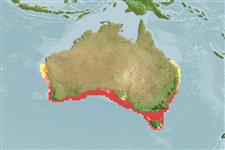Elasmobranchii (haaien en roggen) (sharks and rays) >
Heterodontiformes (Bullhead and horn sharks) >
Heterodontidae (Bullhead, horn, or Port Jackson sharks)
Etymology: Heterodontus: heteros (Gr.), different; odontos (Gr.), tooth, referring to pointy teeth (for clutching prey) at front of jaws, different than rounded molar-like teeth (for grinding hard-shelled invertebrates) at the back. (See ETYFish); portusjacksoni: Of Port Jackson, Sydney, New South Wales, near Botany Bay, type locality. (See ETYFish).
Environment: milieu / climate zone / depth range / distribution range
Ecologie
marien demersaal; oceanodroom (Ref. 51243); diepte 0 - 275 m (Ref. 26346). Subtropical; 23°S - 44°S, 112°E - 154°E
Western Pacific: southern Australia (including Western Australia) and one record from New Zealand. Heterodontus bona-spei from South Africa probably refers to this species.
Lengte bij maturiteit / Grootte / Gewicht / Leeftijd
Maturity: Lm 87.5, range 80 - 95 cm
Max length : 165 cm TL mannelijk / geslacht onbekend; (Ref. 247); common length : 137 cm TL mannelijk / geslacht onbekend; (Ref. 247)
Dorsale stekels (totaal): 2; Dorsale zachte stralen (totaal): 0; Anale stekels 0; Anale zachte stralen: 0. Harness-like narrow dark stripes on back (Ref. 9838).
A common shark of the continental shelves (Ref. 9838), from close inshore at the intertidal zone to 275 m (Ref. 6871). Segregates by sex and maturity stage (Ref. 6871). Nocturnal, hides in caves and rocky gullies during the day (Ref. 6871). Feeds on benthic invertebrates, primarily echinoderms (Ref. 247). Oviparous (Ref. 50449). Eggs with spiral flanges but lack tendrils (Ref. 6871). Undergoes yearly migrations to spawning sites during breeding season (Ref. 247). Considered harmless to people, but can deliver a painful nip when provoked (Ref. 247).
Oviparous. Distinct pairing with embrace (Ref. 205). Undergoes yearly migrations to breeding sites. Females lay about 10 to 16 (commonly 10-12) eggs in rock crevices on shallow sheltered reefs at depths of 1-5 m (rarely 20-30 m) during August and September (rarely in July and October). In captivity, females lay 2 eggs a day every 8-17 days. Eggs are hatched after 9-12 months and young then move into nursery areas in bays and estuaries. After the breeding season, males move into deeper waters followed by the females in late September or October.
Compagno, L.J.V., 1984. FAO Species Catalogue. Vol. 4. Sharks of the world. An annotated and illustrated catalogue of shark species known to date. Part 1 - Hexanchiformes to Lamniformes. FAO Fish. Synop. 125(4/1):1-249. Rome, FAO. (Ref. 247)
Status op de Rode Lijst van het IUCN (Ref. 130435)
Gebruik door de mens
Visserij: van minder commercieel belang; Aquarium: Publieke aquaria
Meer informatie
ReferentiesAquacultuurAquacultuurprofielKweeklijnenGeneticaElectrophoresesErfelijkheidZiektesVerwerkingNutrientsMassaconversie
Tools
Speciale rapporten
Download XML
Internetbronnen
Estimates based on models
Preferred temperature (Ref.
123201): 14.1 - 22.6, mean 16.8 °C (based on 178 cells).
Fylogenetische diversiteitsindex (Ref.
82804): PD
50 = 0.5059 [Uniqueness, from 0.5 = low to 2.0 = high].
Bayesian length-weight: a=0.00347 (0.00255 - 0.00471), b=3.17 (3.08 - 3.26), in cm total length, based on LWR estimates for this species (Ref.
93245).
Trofisch niveau (Ref.
69278): 3.5 ±0.48 se; based on food items.
Weerstandsvermogen (Ref.
120179): laag, minimale populatieverdubbelingstijd 4,5-14 jaar (tm=8-10; Fec=10).
Fishing Vulnerability (Ref.
59153): High to very high vulnerability (72 of 100).
Nutrients (Ref.
124155): Calcium = 17.6 [3.6, 78.9] mg/100g; Iron = 0.653 [0.164, 1.934] mg/100g; Protein = 19.2 [17.1, 21.1] %; Omega3 = 0.215 [0.096, 0.466] g/100g; Selenium = 34.5 [10.4, 97.4] μg/100g; VitaminA = 5.8 [1.9, 16.9] μg/100g; Zinc = 0.526 [0.262, 0.951] mg/100g (wet weight);
